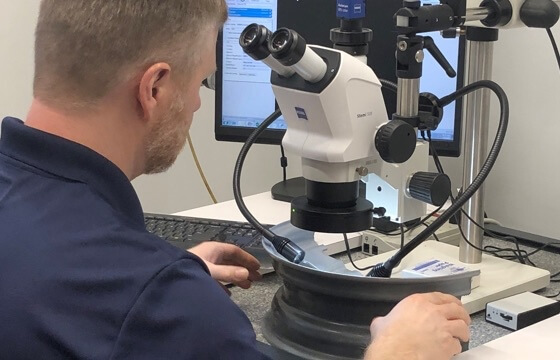Technology Article

Originally posted January 2021 • Updated June 2022
Last year, the Worthington Industries Materials Support team set up an outdoor exposure test station, where science could confront the forces of nature. We reported results to you after one year. And now, at a year and a half, our samples have progressed.
Other research shows that acrylic coating offers generally superior performance in several areas. As a metallurgical leader, our team continually searches for better solutions. We wanted to know: how long would a galvanized surface maintain its gloss under real-world, outdoor conditions? How would it compare to other treatments?
The testing setup
In the Midwest, sunlight, heat, cold, rain, snow, and humidity levels change throughout the seasons, sometimes even all in one day. That makes our backyard an ideal location to observe how environmental conditions impact the appearance of treated, galvanized steel, including the growth of white rust.
We designed the test station to evaluate changes in gloss and appearance due to outdoor exposure. This would serve as a basis for making recommendations on outdoor storage of formed parts at a job site. Samples were angled and separated so water would run off, similar to the requirements for proper outdoor part storage.

THE TEST STATION: On a south-facing rack in an open field, we placed a variety of treated galv samples. Two large acrylic samples on each end test for uniformity of weathering across the coil width.
We put on our coatings
Samples from our own plant and our competitors' were coated with a variety of treatments, including chromate and RoHS passivation, acrylic coating, aluminized, and other, trademarked products.
Once the samples were set up, it was time… to wait. At one year, we saw definite results (below). At 18 months, most of the samples continued to change, albeit slowly. We share the newest results below as well. This is a multi-year project, and it will be interesting to see how long in YEARS each of these coatings will hold up. You could say we're not just testing galv, but also our own patience!!
Chromate and acrylic testing began in October 2020. We checked our samples every week, and collected data on a regular basis, including surface appearance and gloss measurements from a BYK Glossmeter.

18 MONTHS COMPARISON CHART: At the start, there was a period of stability in all the samples, followed by steady loss of gloss that continued through the first 12 months. With the rate of decline in glossmeter numbers slowing, things may be stabilizing for all products. Acrylic is still the standout, with the least dramatic rate of decline.
Results after 1 year/12 months
- After twelve months, white rust was not obvious on any of the samples from a casual, visual examination. However, microscopic examination of the surfaces revealed the actual weathering unseen by the naked eye.
- The RoHS samples became grayer, showing less metallic silver.
- The wide acrylic samples showed uniform appearance across the entire sample.
Results after 1.5 years/18 months
- After 18 months, most samples changed toward a gray appearance instead of metallic silver.
- Under the microscope, few dramatic changes from six months ago were seen.
- White rust growth (Zn carbonate) continued on all of the samples but acrylic.
- Glossmeter readings (avg. 4-5 samples per group) showed a similar trend, with about 50% loss in gloss from the start.
- The RoHS samples show the most change, with the lowest gloss numbers.
- The wide acrylic samples still showed uniform appearance across the entire sample.

ROHS CORROSION: Under the microscope, RoHS passivation had a much larger amount of white coating, possibly contributing to the “grayer” appearance noted above. RoHS shows the lowest gloss numbers throughout the test so far.

12 MONTHS, ACRYLIC VS.CHEMICAL COATING : Acrylic appearance was similar to the start of the test and at six months. High magnification showed no white deposits, except at high spots that may have been abraded in handling. However, the chemical coating/film, on right, shows some white growth.

18 MONTHS, ACRYLIC VS.CHEMICAL COATING : Acrylic still shows barrier protection against corrosion, even with a decrease in gloss. Chemical coating is showing continued, slow growth of Zn carbonate—which is typical for most of the samples.
Conclusions after 18 months
- As expected, samples showed a continuation along the path of natural weathering; the amount of white Zn carbonate (ZnCO3) has increased on all of the chemically treated samples.
- RoHS still had the highest loss of surface gloss of all the samples.
- Acrylic coating still shows superior barrier protection against corrosion, with no significant white ZnCO3 deposits.
- Acrylic's change in gloss is likely due to polymerization of the coating.
Implications for you
We'll keep going with our testing! And keep researching and reporting which coating will be the best for your needs—to hold up better in real-life, outdoor environments. This should help us refine our recommendations for how you store galvanized and maintain its gloss before you make your end product.
We're not expecting significant changes anytime soon, but we'll let you know!
More about galvanized coatings
Our white paper, “The Acrylic Advantage,” details numerous manufacturing benefits that come from using acrylic-coated galvanized steel.


